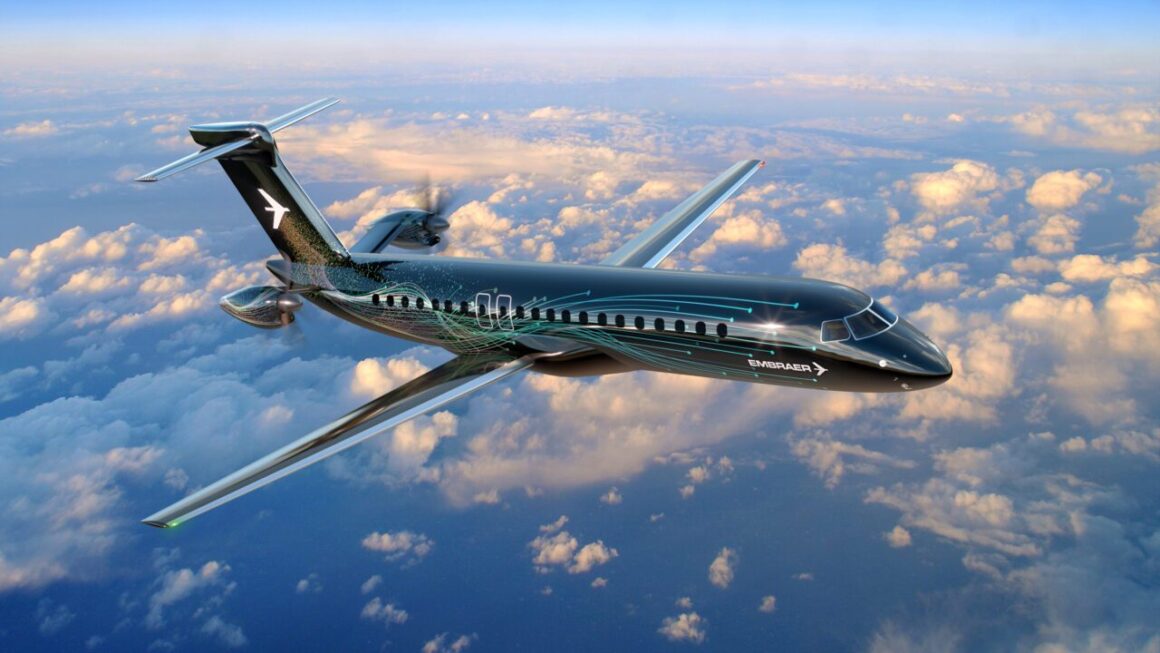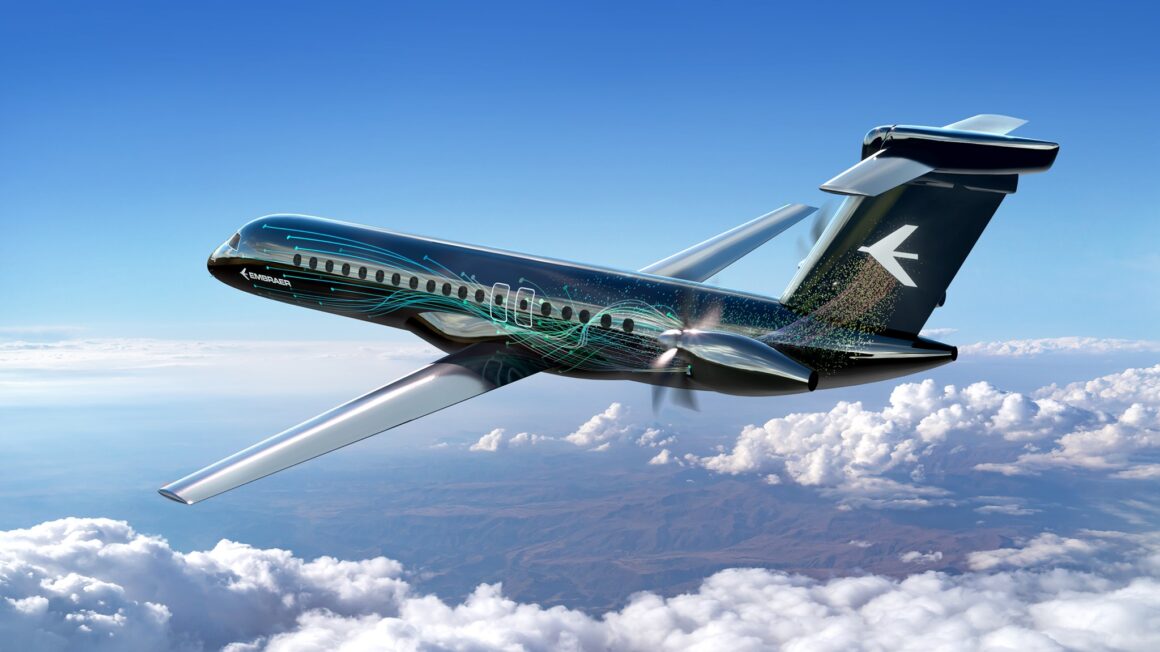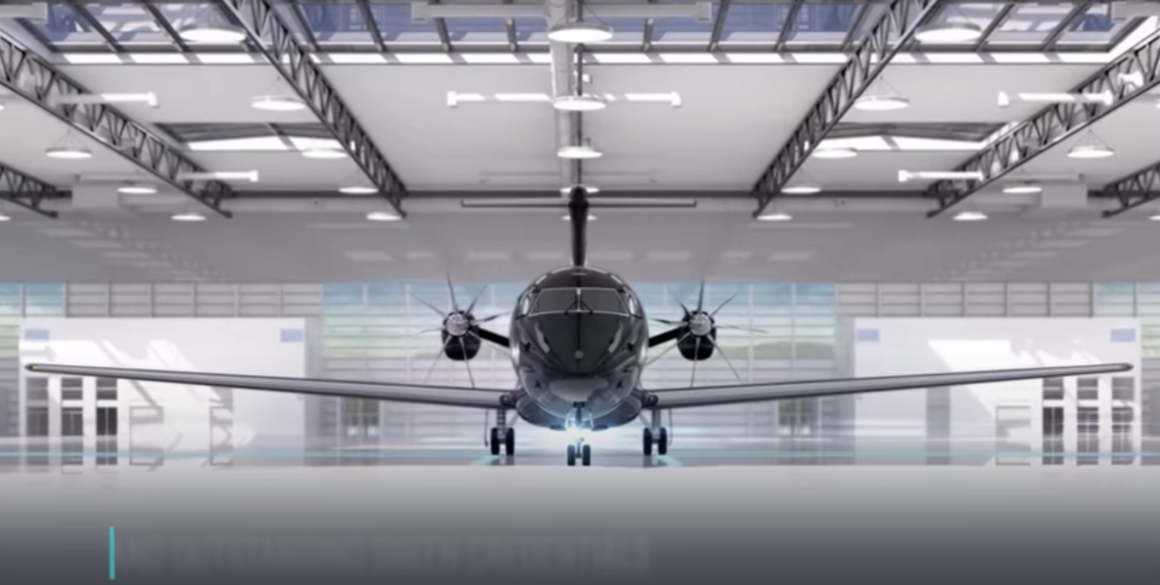Record high fuel prices and an increasing emphasis on sustainability continue to reshape the aviation industry. Is it time to shake things up with a brand new turboprop regional airliner?
Embraer seems to think so.
First proposed as early as 2017, the Brazilian aerospace manufacturer recently showcased its next-gen turboprop (TPNG) in a video titled “The Shape of Things to Come.”
Embraer’s Next-Gen Turboprop Timeline and Features
Embraer Commercial Aviation CEO Arjen Meijer says the TPNG is on track to launch in early to mid-2023. Embraer says it will initially develop 50 and 90-seat variants of the aircraft. The company says it hopes to launch one type in 2028. The other will follow in 2029, although Embraer has not determined which variant will launch first.
Conceptual designs depict a low-wing aircraft with a cross-section much like its E-Jet E2 counterparts (the E175, E190, and E195). The design also features two aft-mounted turboprops and a T-tail.

According to Embraer, the aircraft will feature 10 percent more personal space than the E-Jet E2s. It will travel 20 percent faster, but cost 15 percent less to operate per seat than any turboprop on the market today. Additionally, the aft-mounted engines will provide an overall quieter experience.
Embraer expects to make a powerplant decision by the end of 2022. Meijer says the company is currently in discussions with Pratt & Whitney Canada and Rolls-Royce. General Electric does not plan to offer an engine for the type.
But Is There a Market for Turboprops?

Meijer announced during the 2022 Farnborough Air Show that Embraer has signed letters of intent (LOI) for more than 250 TPNGs, including North American operators. The demand is in line with Embraer’s recent analysis indicating a global need for nearly 11,000 new aircraft with fewer than 150 seats over the next two decades. More than 2,300 – or 21 percent – will be turboprops.
It may seem difficult to imagine a future where carriers – particularly in the United States – once again rely on turboprops to connect smaller communities in their systems. With the advent of the regional jet age in the late 1980s and early 1990s, many believed the turboprop would soon become relegated to the annals of aviation history. Sleek new regional jets that were fast and quiet began to dominate the skies. It seemed the future of aviation had arrived.
In recent years, however, we have seen that regional jets are inefficient and not necessarily well-loved by fliers (or crew). That led to airlines shedding regional jets from their fleet. This process sped up exponentially during the COVID-19 pandemic as air travel demand plummeted. Amid the pandemic, airlines tried everything they could to stay solvent. When air travel finally began to recover as the pandemic waned, major airlines that had offered early retirement to pilots now faced a glut of openings. The obvious choice to fill those positions was to hire pilots from regional carriers. But as those pilots moved to mainline carriers, staffing woes began to affect the regionals. As regional jet fleets dwindled, small communities began to face service reductions – or even lost airline service altogether.
No real replacement for aircraft in the 50 to 70-seat range is in development. Smaller communities unable to sustain anything larger are already losing air service and more are sure to follow. Cities like Dubuque, Iowa (DBQ) or Williamsport, Pennsylvania (IPT) just can’t support mainline service. So what will fill the void? Will we see a renaissance of sorts for the turboprop market? Embraer is betting on it.
Embraer Plans to Shake Up a Stagnant Market

If Embraer’s TPNG program succeeds, it will disrupt a sector of the aviation industry that hasn’t changed much in recent decades. Despite some minor cosmetic and technological advances, the two dominant players in today’s turboprop market – the de Havilland Canada Dash 8 Q400 and the ATR-72 – are essentially the same as when their original variants launched in 1983 and 1985, respectively.
High fuel prices, new technology, and an increased push for decarbonization are creating opportunities for a transformational moment in the industry. Yes, other manufacturers have taken steps toward innovation, but Embraer is truly embracing the moment. By doing so, it will not only radically shake up the stagnant turboprop industry, it will lead it into an innovative, greener, and more sustainable future.
